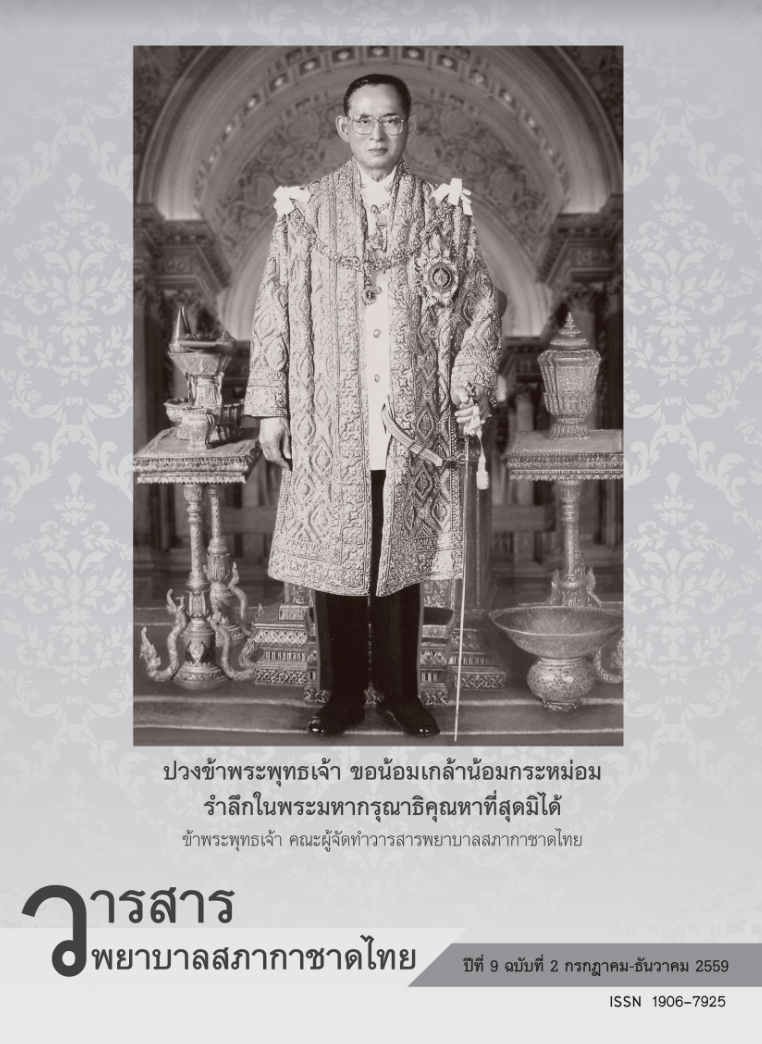การนำผลการวิจัยทางการพยาบาลไปใช้ในคลินิก
Keywords:
วิจัยทางการพยาบาล, การนำผลการวิจัยไปใช้ในคลินิก, nursing research, research utilizationAbstract
การนำผลการวิจัยทางการพยาบาลไปใช้ เป็นการใช้ผลการวิจัยหรือการบูรณาการความรู้จากการวิจัยไปใช้ในการปฏิบัติการพยาบาล มีวัตถุประสงค์เพื่อถ่ายทอดผลงานวิจัยลงสู่การปฏิบัติ และเป็นการพัฒนาคุณภาพการพยาบาล บทความนี้เป็นประสบการณ์ของผู้เขียนในการนำผลการวิจัยทางการพยาบาลไปใช้ในคลินิก ซึ่งดำเนินการตามรูปแบบของสเต็ทเลอร์ (Stetler) 5 ขั้นตอน คือ ขั้นตอนที่ 1 ขั้นเตรียมการ เป็นการวิเคราะห์ปัญหาที่ผู้ป่วยมะเร็งที่ได้รับเคมีบำบัดและ/หรือการฉายแสงเกิดผลข้างเคียง คือ มีอาการคลื่นไส้ ขย้อนและ/หรืออาเจียน ขั้นตอนที่ 2 ขั้นวิเคราะห์ตรวจสอบ โดยประเมินจุดแข็งและจุดอ่อนของงานวิจัย ขั้นตอนที่ 3 เป็นการประเมินเปรียบเทียบประโยชน์หรือความเสี่ยงที่เกิดขึ้นระหว่างการใช้ยาบรรเทาอาการ และการพยาบาลที่ผู้ป่วยได้รับในปัจจุบันกับการทำจินตนาการบำบัดและการกดจุด ขั้นตอนที่ 4 เป็นการติดต่อประสานงานและการลงมือปฏิบัติโดยนำผลการวิจัยไปใช้ รวมทั้งเตรียมโครงการฝึกอบรมพยาบาลแกนนำ และขั้นตอนที่ 5 เป็นการประเมินผล พบว่าผู้ป่วยมะเร็งที่ได้รับการรักษาด้วยเคมีบำบัดและ/หรือการฉายแสงร้อยละ 86.38 มีคะแนนอาการคลื่นไส้ ขย้อนและอาเจียนลดลง และพบว่าค่าเฉลี่ยความพึงพอใจของพยาบาลกลุ่มแกนนำ เท่ากับ 4.33 ค่าเฉลี่ยความพึงพอใจของผู้ป่วยเท่ากับ 4.19 ส่วนปัญหาและอุปสรรคในการดำเนินโครงการ คือ พยาบาลมีงานประจำมาก รวมทั้งระยะเวลาในการปฏิบัติงานไม่เอื้อในการดำเนินโครงการ และมีผู้ป่วยเข้าร่วมโครงการน้อยกว่าที่กำหนดไว้ เนื่องจากในช่วงการดำเนินโครงการ ไม่มีผู้ป่วยมะเร็งตามเกณฑ์ในการคัดเลือกมาเข้ารับการรักษา
Nursing Research Utilization in Clinical Settings
Nursing research utilization transfers the knowledge of nursing research into nursing practice. The purposes of research utilization in nursing include disseminating research findings and translating scientific evidence for its use in nursing practice, as well as improving the quality of nursing care. This manuscript describes the author’s first-hand experience and clinical expertise in promoting evidence-based practice in nursing based on the Stetler model of research utilization. Five sequential phases are: 1) preparation (defining problems in patients with cancer who receive chemotherapy and/or radiotherapy treatments, such as nausea and vomiting); 2) validation (conducting a critique of sources of evidence focusing on strengths and weaknesses); 3) comparative evaluation and decision making (synthesizing findings and determining the feasibility of applying the method of imagination and acupressure as compared to using medication and current standard of care); 4) translation/application (collaborating, implementing research findings, and formulating the operational details of the project, such as training nurse leaders); and 5) evaluation (evaluating outcomes that indicated 86.38% of cancer patients undergoing chemotherapy reported a reduction in nausea and vomiting The average scores of satisfaction were 4.33 in nurse leaders, and 4.19 in cancer patients). The challenges and limitations in this study were the heavy workload among nurse leaders and the study duration that impeded the implementation of the proposed project. Furthermore, there was a limited number of cancer patients available during the study.
Downloads
Issue
Section
License
เนื้อหาบทความหรือข้อคิดเห็นต่างๆ ในวารสารพยาบาลสภากาชาดไทยนี้ เป็นความคิดเห็นของผู้เขียนบทความ ไม่ใช่ความเห็นของกองบรรณาธิการ หรือสถาบันการพยาบาลศรีสวรินทิรา สภากาชาดไทย






